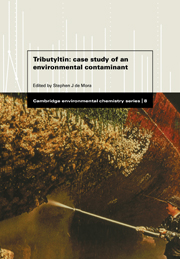Book contents
- Frontmatter
- Contents
- Contributors
- Preface
- 1 The tributyltin debate: ocean transportation versus seafood harvesting
- 2 Industrial manufacture and applications of tributyltin compounds
- 3 The analysis of butylated tin compounds in the environment and in biological materials
- 4 The occurrence, fate and toxicity of tributyltin and its degradation products in fresh water environments
- 5 The distribution and fate of tributyltin in the marine environment
- 6 Biological effects of tributyltin on marine organisms
- 7 TBT-induced imposex in neogastropod snails: masculinization to mass extinction
- 8 Environmental law and tributyltin in the environment
- 9 The efficacy of legislation in controlling tributyltin in the marine environment
- Index
2 - Industrial manufacture and applications of tributyltin compounds
Published online by Cambridge University Press: 04 August 2010
- Frontmatter
- Contents
- Contributors
- Preface
- 1 The tributyltin debate: ocean transportation versus seafood harvesting
- 2 Industrial manufacture and applications of tributyltin compounds
- 3 The analysis of butylated tin compounds in the environment and in biological materials
- 4 The occurrence, fate and toxicity of tributyltin and its degradation products in fresh water environments
- 5 The distribution and fate of tributyltin in the marine environment
- 6 Biological effects of tributyltin on marine organisms
- 7 TBT-induced imposex in neogastropod snails: masculinization to mass extinction
- 8 Environmental law and tributyltin in the environment
- 9 The efficacy of legislation in controlling tributyltin in the marine environment
- Index
Summary
Organotin compounds
Although organotin compounds were first identified in the mid nineteenth century, industrial development of these chemicals did not occur until nearly a century later. Over the past 40 years world production and usage of organotin compounds has grown to a level that is currently estimated to be at around 50 000 tonnes per annum. The major industrial application of organotin compounds is with the mono- and di- derivatives, which are used as heat and light stabilizers in PVC processing. Mono/dibutyltin derivatives find widespread application in pipe, sheeting and other rigid PVC manufacture. Octyltin thioglycolate derivatives are approved worldwide as stabilizers for PVC used in food packaging materials and in bottles used for potable liquids. Thio-organotin stabilizers have the unique advantage of producing crystal clear PVC.
Triorganotin compounds are biologically active. They represent a smaller tonnage market – between 15 and 20% of total organotin world manufacture. Triorganotin compounds have an important place in the agrochemical field as fungicides and miticides, with the production and use of about 5000 tonnes per annum. Triphenyltin compounds (the acetate and hydroxide) are of particular importance in potato crop blight control. There was usage of triphenyltin derivatives in anti-fouling paint manufacture during the period 1960–85. Such usage has virtually disappeared from all world markets. Trineophyltin and tricyclohexyltin derivatives are used as miticides/acaricides. Tributyltin compounds were first examined for their biological properties in the early 1950s at the Institute for Organic Chemistry TNO, Utrecht, Holland (van der Kerk & Luijten, 1954).
- Type
- Chapter
- Information
- TributyltinCase Study of an Environmental Contaminant, pp. 21 - 61Publisher: Cambridge University PressPrint publication year: 1996
- 28
- Cited by



